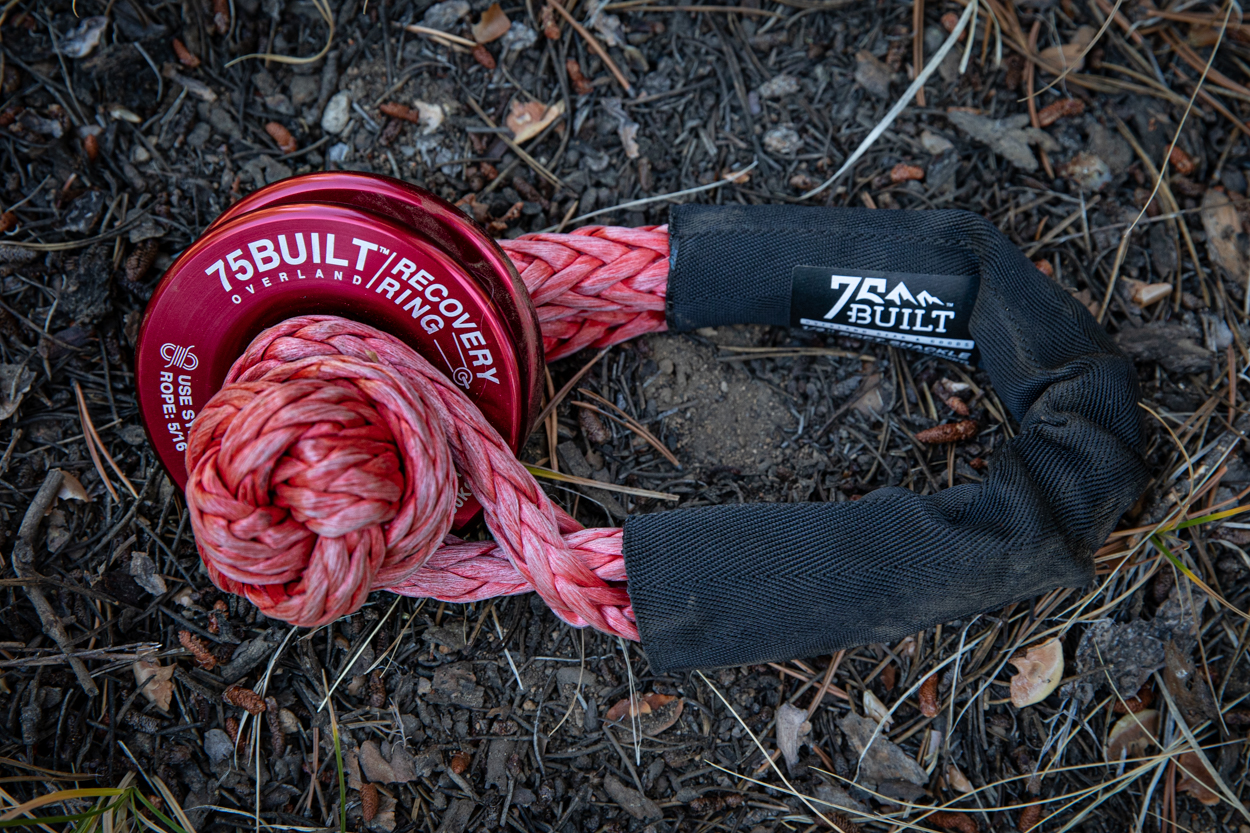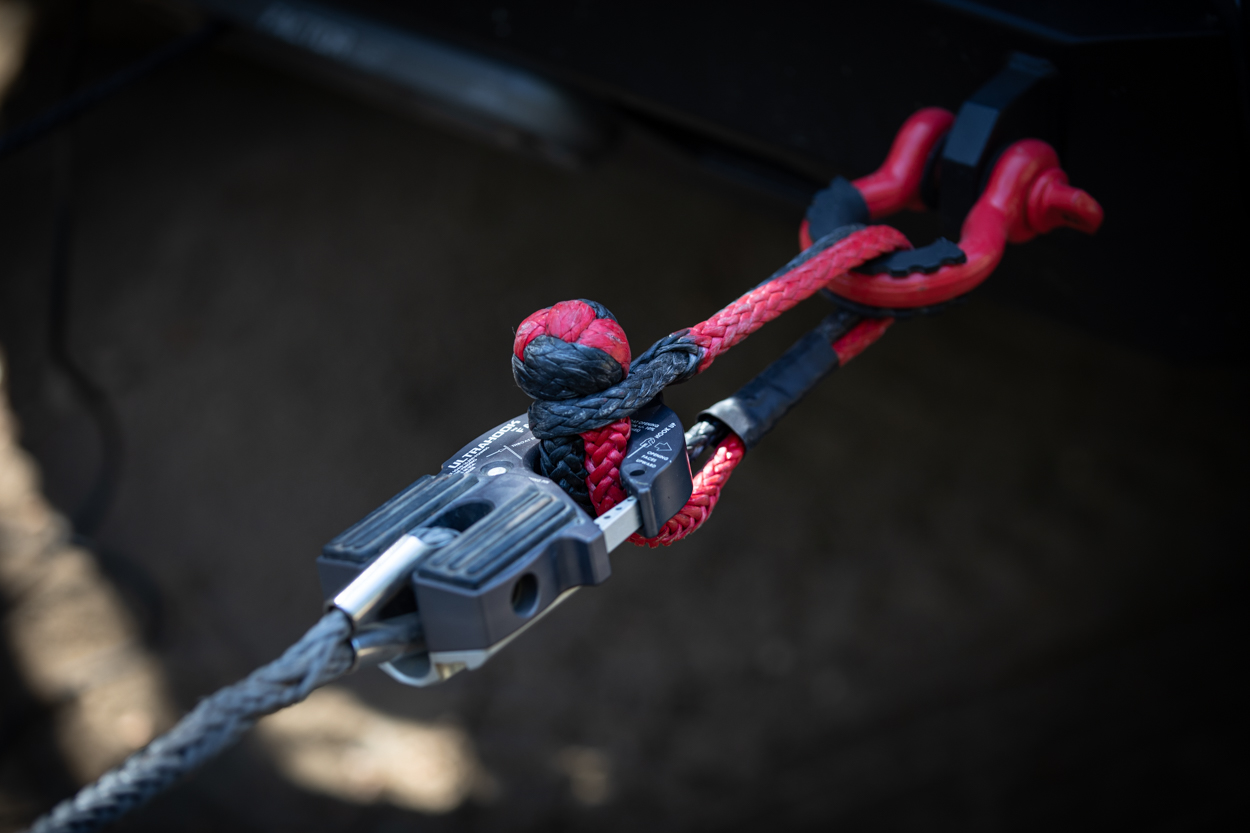
Compact, Light-Weight, and Effective – Recovery Rings are a Key Part of your Recovery Kit
How often have you taken inventory of your toolkit? Added to it? Removed things from it? Swapped things out?
Are you always in search of the perfect conglomeration of tools you absolutely need, and tools you pray you won’t ever have to use? I’m not a hard-core “wheeler”, so I’m not breaking my rig every weekend, but every time I pick up my tool bag, I weigh the contents mentally and physically.
As a rule of thumb, I try to equip myself rather well, but at the same time keep my gear on the lighter side and a bit more compact. About 6 months ago, I bought my first snatch block and when it arrived on my doorstep I pulled it out of the box and was like “holy sh*t this thing is heavy”.
I knew immediately it wasn’t something I’d keep in my drawers or in my tool bag… which is one of the reasons I was so excited to pick up this 75Built winch recovery ring. It has replaced the snatch block in my bag and will definitely be a part of my essentials for the long haul.
Find It Online
- 75Built Recovery Ring: Check Price
What is a Winch Recovery Ring, and Why Do You Need One?
First of all, let’s get acquainted with this little gizmo, and then we’ll talk briefly about why you need it and how to use it.
Simply put, the 75Built Recovery Ring is an efficient way to double your winching power or to change the direction of a pull if needed.
The aluminum rings are made from the strongest 7075 aluminum, the anodized finish has a premium look and feel, and the graphics are super clean. The specs and logo are cleanly laser-etched into the ring itself. It has no moving parts to muck up with mud or debris and is arguably the safest way to recover your vehicle. It’s also super lightweight and compact, so it doesn’t take too much room in your toolkit.
Key Features and Specs:
- Heavyweight strength without the weight of a snatch block
- Comes with a ripstop storage bag
- Made for large size 4×4 trucks and SUV’s
- Friction-free rounded edges that won’t damage your winch rope
- An anodized protective oxide layer
- Precision CNC machined 7075 billet aluminum
- For various synthetic rope diameters 5/16”, 3/8”, 1/2”, 5/8” (8 – 16 mm)
- Designed for use with 1/2” soft shackles
- General working load limit 22,000 lbs
- Safer than steel snatch blocks
- No moving parts that will fail or clog with mud or dirt
- One ring doubles your winching capacity
Why get a Recovery Ring?
Other than the fact that it just looks cool, there are two general situations when you’d need a recovery ring:
- To double your winching power.
- To change the direction of your pull.
Double the winching power

In a single-line pull, your winch line comes directly out of the winch and attaches to a recovery point. In a double-line pull, which is what we tested here, your winch line comes out of the winch, wraps around the recovery ring (which is attached to a recovery point), and then attaches to a mounting point on the recovering vehicle. This setup results in the winch pulling itself out from the front bumper instead of pulling against a mounting point like a tree.
In the double-line scenario, winching power is doubled as a result of the line only having to move half the distance. Or as they say, “Because, math.” This results in the winch motor working less, and the feeling of a more effortless recovery. It’s also just cool watching the line spool through that shiny red ring.
The length of cable you spool out of your winch also affects the power of the pull. The less line you reel out, the less power you’ll get. For maximum power, unwind enough cable to leave only one layer on the drum of the winch. If your anchor point (for example, a tree with a tree-saver strap) is too close to spool out enough rope, you can double up your line using a recovery ring, which allows you to spool out double the amount of rope.
Change the direction of your pull
Not all recovery situations present an anchor point directly in front of the vehicle. Like a snatch block, you can use the recovery ring to create an angle in your line and the anchor point (like a tree) is used to redirect the pull. I didn’t test this scenario, so we’ll focus on the single-line pull. This is also a relatively rich topic and may need a separate post to cover it in detail.
How do you use it?

First, it’s key to attach the soft shackle to the ring appropriately. See above. Position the knot at the top of the ring, seated just on top of the loop of the soft shackle. The doubled rope will be going through the hole in the recovery ring resulting in a stronger point of contact and a smoother spinning ring.

Run your synthetic winch line around the exterior grooves of the ring and attach your soft shackle to your recovery point. In this case, we’re showing a self-recovery using a tree saver. Pull the winch line back toward your vehicle and connect to a strong recovery point. I used the shackle mount on my front bumper, which is adjacent to my winch.

At the bumper end, I used another soft shackle attached to my winch hook. I could have just used the hard shackle or the soft shackle instead of both, and had one less spot for potential failure within the system. But, I was on flat ground and only doing a simple test.
Still… better to keep the system simple with fewer parts. Ideally, I’d remove the hard shackle and just attach the soft shackle to the shackle mount directly on the bumper. Or, just attach the hook to the hard shackle.

I’m clearly not stuck in this scenario. Funny when you go out looking to get stuck, it just doesn’t happen.
Once everything is all safely hooked up, you can put the vehicle in neutral and operate your winch. Usually, you’d be stuck and likely want to give the rig a little throttle.
I didn’t want to introduce slack into the system, so I kept my foot off the gas and let the winch and recovery ring do the work. It did just that. I had a super smooth “recovery” with the rig rolling forward nice and easy. Once unstuck, I put the rig in park and engaged the parking brake.
Then I spooled out a little slack in the winch line with my winch control. Once there’s some slack, the system is pretty safe, so I disengaged the clutch and loosened the line. Then I disconnected all the equipment and stowed it back in my toolkit.
Final thoughts
When I held the 75 Built recovery ring in my hands for the first time, I knew it was good quality and would be a simple and helpful piece of equipment. It’s super sleek and lightweight, especially when compared with the alternative snatch block.
The finish is premium, the operation is super simple, and it has zero moving parts to worry about. In my opinion, the best part is the amount of space it saves in my toolkit, not to mention having the ability to double your winching power.
If you have a winch on your rig, the 75built Recovery Ring is definitely an essential addition to your tool bag of tricks.






Looks like a safe system that really does the job too. Great write up
Nice. I noted the soft shackle was not included. Can that be purchased as well?
Hey. Yeah, pretty sure you can still get the soft shackle either as a package with the recovery ring or separate.